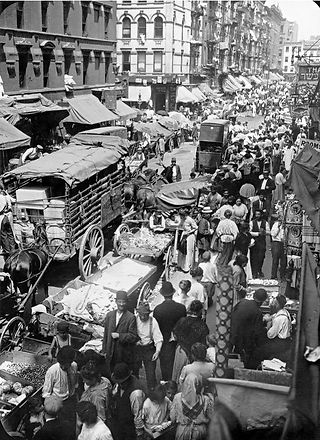
Tenement "apartment" in New York City's notorious Lower East Side
You deicde to locate your relatives and get work as quickly as possible. You pull out a letter from your mom's cousin whom you've met once in Russia. The address on the envelope reads '209 Hester Street Apt 3B'. New York is so large you have no idea where you are at much less how to find this Hester Street. You start by asking people on the street but they can't understand your broken English. Standing across the street from you is a man who is obviously Jewish based on his traditional clothing.
Dodging horse drawn wagons and the occasional motorized vehicle, you make your way over to ask him if he knows where Hester Street is. You are excited when he greets you with a hearty, "Shalom!" He tells you that the place you are looking for is an area on the Lower East Side known as the Hebrew District. It's not far from where you are, only about 15 blocks.
In the Hebrew District you begin to feel hopeful about the future in America. You wish your mother and sisters were here to share this little miracle with you. The streets are packed with Jews, some rich, most poor, all of whom are going about their business. The streets are packed with vendors, tailors, grocers, in one great mass of humanity. You occasionally hear an English phrase thrown in among the Yiddish voices.
Your heart falls when you get to Hester Street; a slum in many ways like the one you left behind in Russia but on a much bigger scale. Everywhere peddler's carts line both sides of the streets selling goods from the Old Country. One cart carries apples and pears. Another carries kosher pickles and sandwiches. Along the sidewalks are the tiny shops and homes that seem to be stacked on top of one another to form giant buildings 4 and 5 stories high! The bottom level is reserved for shops and restaurants. From the windows above hang laundry or the heads of children watching the crowds below. You quickly learn that a shout from one of the upper floors almost always is followed by the emptying of a pot of human waste or dirty water.
You find the building number you are looking for and climb the stairs to the fifth floor. The stairways are dark and windowless, and in the gloom you almost trip over young boys playing there. The smell of cabbage and fish mixes with sweat and urine. The tenement that your cousin lives in is like hundreds of other apartments for the poorest of the poor.
Your cousin greets you with a hug and kiss on the cheek. She holds the door open for you and you are immediately struck with how dark the apartment is. Even though it is midday, an oil lamp hung from a ceiling hook is burning. Once your eyes adjust to the gloom you see that the entire apartment is only three tiny rooms. One bedroom is where your cousin and her husband sleep, the other with a single bed, is for their four children. The main room is furnished with a few cheap chairs, a table for eating, and a sink and wood stove tucked into the corner. Two toilets, you learn, are shared by the residents of the entire floor.
She welcomes you to stay but you can hardly imagine where there would be enough room for you to sleep. They tell you that unfortunately they cannot let you stay for free. You'd have to help pay your share of the rent.
Your cousin and her family work as tailors for a factory owner who pays them by the piece. They tell you that if you help them with the work they will share the profits with you as well.


Lower East Side New York 1903
Hebrew District